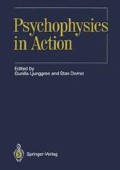Abstract
This chapter focuses and elaborates on an eight-factor model of the processes by which people make decisions and select responses. The model is part of a larger conceptual framework (called human self-assessment process theory) which describes how people might make self-assessments of the state of their own subsystems and how these self-assessments affect their decisions, and the selection and execution of responses. We think the topic, because of its potential use for making predictions and in understanding how and why people behave as they do, is deserving of more systematic consideration than it has received.
An intervening variable approach is employed to explore the development and the effects of associations:
-
1.
Between responses and particular consequences (later events) — called response-consequence associations
-
2.
Between perceived situations and later events — called situation-consequence associations
-
3.
Between perceived situations and responses — called situation-response associations
These associations involve what may be called cause and effect relationships. The condition(s) which a person identifies as the cause(s) is affected by many factors such as (a) the person’s educational and experiential background, (b) the gains and costs related to errors of causal inference, (c) the conditions over which the person has control — called the principle of relativity of causes, (d) human biases exhibited when diagnostic conclusions based on past hypotheses-symptom data are more sure than is warranted, and (e) the necessity that an informational relation exist between two events before a person will form a cause-effect association between them; repeated observation of regularity between events is neither sufficient nor necessary for a person to infer a cause—effect relation.
Access this chapter
Tax calculation will be finalised at checkout
Purchases are for personal use only
Preview
Unable to display preview. Download preview PDF.
References
Bobrow, D.G. (1975). Dimensions of representation. In D.G. Bobrow & A. Collins (Eds.), Representation and understanding: Studies in cognitive science. New York: Academic.
Bolles, R.C. (1972). Reinforcement, expectancy and learning. Psychological Review, 79 (5), 394–409.
Borg, G. & Ottoson, D. (1986). The perception of exertion in physical work. London: Macmil-lan.
Chaplin, J. P. & Krawiec, T.S. (1968). Systems and theories of psychology. New York: Holt, Rinehart and Winston.
Collingwood, R.G. (1976). Causation. In M. Brand (Ed.), The nature of causation. Urbana, IL: University of Illinois Press.
Crouse, R.W. (1980). The novelty of human self-assessment: Implications for learning and training. Unpublished master’s thesis, New Mexico State University, Las Cruces.
Ducasse, C.J. (1976). Causality: Critique of Hume’s analysis. In M. Brand (Ed.), The nature of causation. Urbana, IL: University of Illinois Press.
Eddy, D. M. (1982). Probabilistic reasoning in clinical medicine: Problems and opportunities. In D. Kahneman, P. Slovic & A. Tversky (Eds.), Judgment under uncertainty: Heuristics and biases. New York: Cambridge University Press.
Fernandez, J. (1982). Self-assessment and decreasing stimulus duration. Unpublished master’s thesis, New Mexico State University, Las Cruces.
Gentner D. & Stevens A. L. (1983). Mental models. Hillsdale, NJ: Erlbaum.
Hellriegel, D., Slocum, J.W. Jr. & Woodman, R.W. (1983). Organizational behavior ( 3rd ed. ). New York: West Publishing.
Hughes, C.R. (1975). The relationship between self-assessment and response choice during learning. Unpublished master’s thesis, New Mexico State University, Las Cruces.
Hunt, D.P. (1976). The human self-assessment process: Study I. Its accuracy, effects on acquisition and a tentative model (An Interim Report). Alexandria, VA: U.S. Army Research Institute for the Behavioral and Social Sciences.
Hunt, D. P. (1977). The human self-assessment process: Study II. The effects of the number of self-assessment categories on acquisition (An Interim Report). Alexandria, VA: U.S. Army Research Institute for the Behavioral and Social Sciences.
Hunt, D.P. (1978). A human self-assessment process (A final report). Alexandria, VA: U.S. Army Research Institute for the Behavioral and Social Sciences.
Hunt, D.P. (1981). A human self-assessment process (Tech. Rep. No. 466 ). Alexandria, VA: U.S. Army Research Institute for the Behavioral and Social Sciences.
Hunt, D.P. ( 1982 a). Human self-assessment responding: A consideration of the motor component and of the speed and accuracy of self-assessment responding (An Interim Report). Alexandria, VA: U.S. Army Research Institute for the Behavioral and Social Sciences.
Hunt, D.P. (1982b). Effects of human self-assessment responding on learning. Journal of Applied Psychology, 67, 75–82.
Hunt, D. P. (1984). Human self-assessment and its implications for human training and performance. Alexandria, VA: U.S. Army Research Institute for the Behavioral and Social Sciences.
Hunt, D.P. (1986). The ability of people to make self-assessments of the state of their own subsystems: Implications and the process. In G. Borg & D. Ottoson (Eds.), The perception of exertion in physical work. London: Macmillan.
Jagacinski, R.J. & Miller, R. A. (1978). Describing the human operator’s internal model of a dynamic system. Human Factors, 20, 425–433.
Kelley, C.R. (1968). Manual and automatic control: A theory of manual control and its application to manual and to automatic systems. New York: Wiley.
Klein, R.M. (1976). Attention and movement. In G.E. Stelmach (Ed.), Motor control. New York: Academic.
Rescorla, R.A. (1987). A Pavlovian analysis of goal-directed behavior. American Psychologist, 42, 119–129.
Sams, M. (1986). Effects of testing methods and self-assessment responding on observers and performers. Unpublished master’s thesis, New Mexico State University, Las Cruces.
Shurtleff, M. (1987). Training novice troubleshooters to use the half-split rule. Unpublished master’s thesis, New Mexico State University, Las Cruces.
Skinner, B. F. (1987). Whatever happened to psychology as the science of behavior. American Psychologist, 42, 780–786.
Editor information
Editors and Affiliations
Rights and permissions
Copyright information
© 1989 Springer-Verlag Berlin Heidelberg
About this chapter
Cite this chapter
Hunt, D.P., Sams, M.R. (1989). Human Self-Assessment Process Theory: An Eight-Factor Model of Human Performance and Learning; and Everyman’s Causation. In: Ljunggren, G., Dornic, S. (eds) Psychophysics in Action. Springer, Berlin, Heidelberg. https://doi.org/10.1007/978-3-642-74382-5_4
Download citation
DOI: https://doi.org/10.1007/978-3-642-74382-5_4
Publisher Name: Springer, Berlin, Heidelberg
Print ISBN: 978-3-642-74384-9
Online ISBN: 978-3-642-74382-5
eBook Packages: Springer Book Archive

